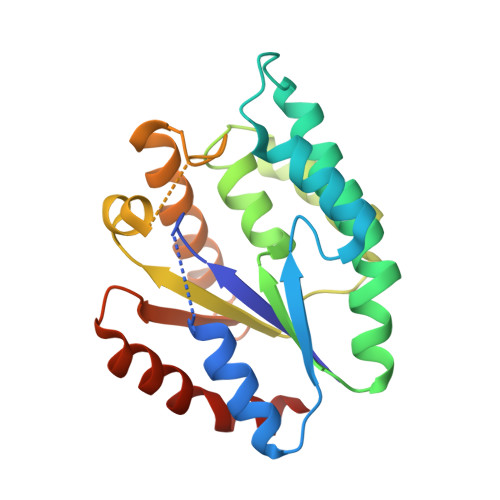Structure guided development of novel thymidine mimetics targeting Pseudomonas aeruginosa thymidylate kinase: from hit to lead generation.
Choi, J.Y., Plummer, M.S., Starr, J., Desbonnet, C.R., Soutter, H., Chang, J., Miller, J.R., Dillman, K., Miller, A.A., Roush, W.R.(2012) J Med Chem 55: 852-870
- PubMed: 22243413
- DOI: https://doi.org/10.1021/jm201349f
- Primary Citation of Related Structures:
3UWK, 3UWO, 3UXM - PubMed Abstract:
Thymidylate kinase (TMK) is a potential chemotherapeutic target because it is directly involved in the synthesis of an essential component, thymidine triphosphate, in DNA replication. All reported TMK inhibitors are thymidine analogues, which might retard their development as potent therapeutics due to cell permeability and off-target activity against human TMK. A small molecule hit (1, IC(50) = 58 μM), which has reasonable inhibition potency against Pseudomonas aeruginosa TMK (PaTMK), was identified by the analysis of the binding mode of thymidine or TP(5)A in a PaTMK homology model. This hit (1) was cocrystallized with PaTMK, and several potent PaTMK inhibitors (leads, 46, 47, 48, and 56, IC(50) = 100-200 nM) were synthesized using computer-aided design approaches including virtual synthesis/screening, which was used to guide the design of inhibitors. The binding mode of the optimized leads in PaTMK overlaps with that of other bacterial TMKs but not with human TMK, which shares few common features with the bacterial enzymes. Therefore, the optimized TMK inhibitors described here should be useful for the development of antibacterial agents targeting TMK without undesired off-target effects. In addition, an inhibition mechanism associated with the LID loop, which mimics the process of phosphate transfer from ATP to dTMP, was proposed based on X-ray cocrystal structures, homology models, and structure-activity relationship results.
Organizational Affiliation:
Department of Chemistry, Scripps Florida, Jupiter, Florida 33458, United States.
















